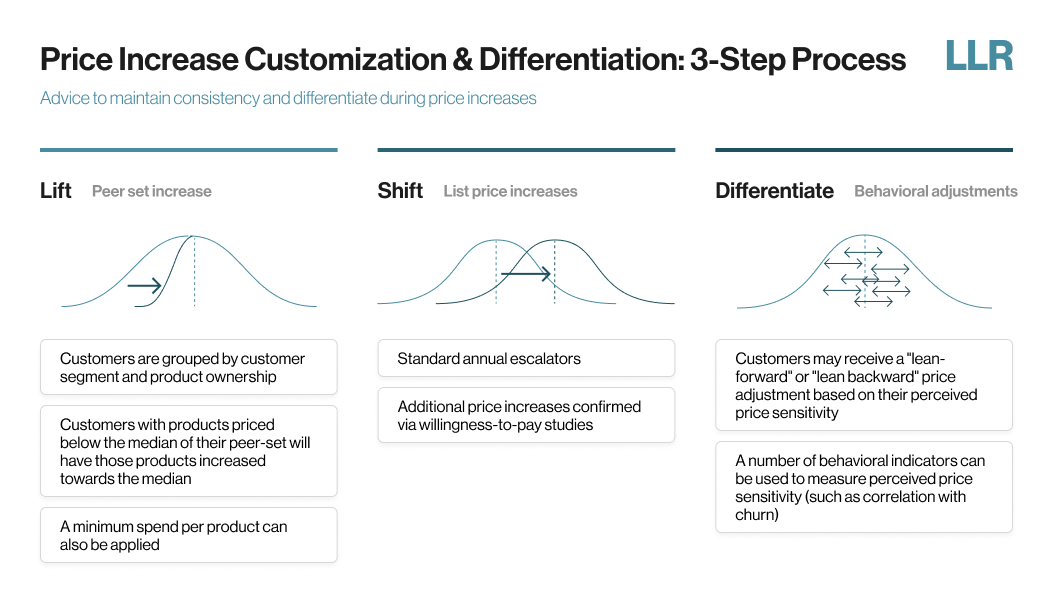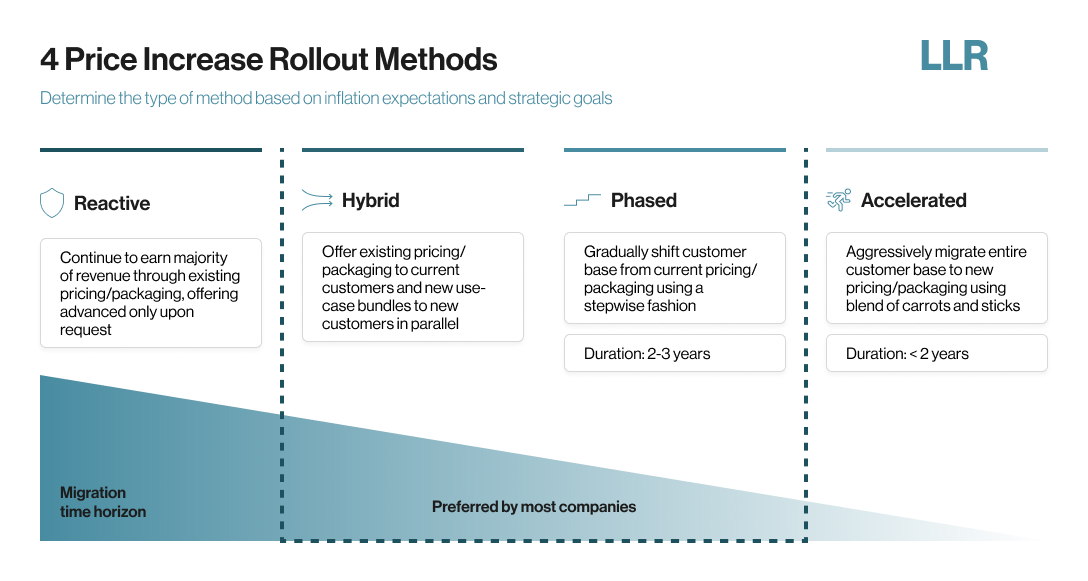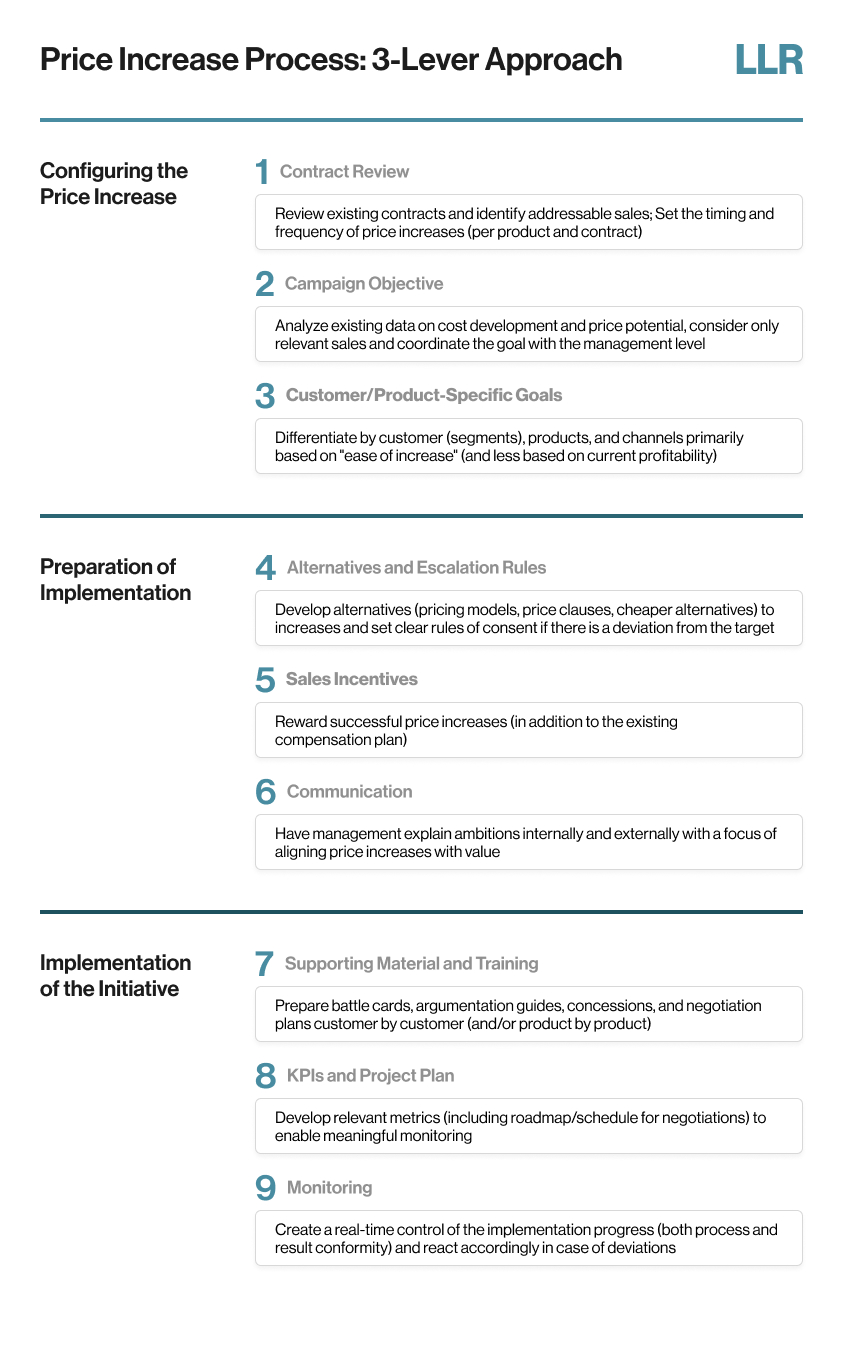The Power of Price: How to Increase Prices Across Your Existing Customer Base
Successful price increases don’t happen by chance. When done right, price increases communicate your commitment to continuous improvement and long-term partnership.
Consider this statistic: a mere 1% improvement in price can help boost EBITDA by about 6%.1 That’s more impact than you may see from other cost-reduction efforts.
Companies often focus on cutting costs or increasing sales volume to improve their bottom line. After all, it’s tangible, measurable, and frankly, feels safer. However, there’s a more nuanced and often overlooked lever: strategic price increases.
Successful price increases don’t happen by chance. In this GrowthBit, we’ll share our thoughts on how to design a price increase and successfully launch it across your customer base in a way that helps gain traction and mitigate churn. We’ve found a structured, three-stage approach to be one of the most effective methods of executing strategic pricing adjustments.
Stage 1: Configuring the Price Increase
Contract Review
Start by understanding what is and isn’t addressable within existing contracts to strategically set the timing and frequency of price increases. Leverage contract dates to drive urgency for price adjustments, creating natural opportunities for discussion.
Campaign Objectives & Customization
With a clear view of contractual possibilities, establish precise expectations in both dollar amounts and customer counts. For price increases, use a scalpel, not a sledgehammer. Instead of a blanket increase, customize approaches based on specific customer segments, products, and channels. To customize price increases, we suggest using a three-step process: lift, shift and differentiate.
Peer set increase (“lift”): Analyze peer set increases, considering factors like customer segment and product ownership.
List price increases (“shift”): Evaluate list price increases and implement standard annual escalators in contracts.
Behavioral adjustments (“differentiate”): Factor in behavioral adjustments, including customer health, product usage and strategic importance.
Tailoring your strategy based on the ease of increase rather than current profitability can help maximize the effectiveness of each price adjustment.
Tailoring your strategy based on the ease of increase rather than current profitability can help maximize the effectiveness of each price adjustment. This is typically a cross-functional process involving customer success, account management, finance and revenue operations.
Stage 2: Preparation of Implementation
Your approach to a price increase can significantly impact customer acceptance, revenue realization and overall success of the initiative. The key is to align your implementation with overall business objectives and customer relationship goals.
Four common implementation methods:
Reactive: Involves maintaining your existing pricing structure for current customers and only introducing new pricing upon request. This method is the most conservative but can significantly slow down the adoption of new pricing.
Hybrid: Introduces new pricing for all new customers while existing customers maintain their current pricing until renewal. This helps to balance new revenue generation with existing customer satisfaction.
Phased: Cohorts of customers are moved to new pricing over time. Start with the strongest customers first, learning the pitfalls through each migration phase to refine your approach. This allows you to test and improve your pricing strategy while minimizing disruption to your customer base.
Accelerated: Involves switching all customers to new pricing at once. While this can lead to the quickest adoption of new pricing, it often drives higher churn rates.
Tie the increase to your product roadmap and emphasize the added value customers will receive, rather than citing costs or inflation.
We believe the “best” approach depends on your business. We’ve often seen a combination of hybrid and phased methods work best. Success hinges on clear communication: tie the increase to your product roadmap and emphasize the added value customers will receive, rather than citing costs or inflation. By carefully selecting and executing the right implementation approach, and backing it with strong, value-focused communication, you can maximize the success of price increases.
Stage 3: Implementation & Enablement
At the core of implementation is equipping teams with the tools to address topics that inevitably arise during customer discussions. Customers are typically more receptive to price increases when they understand the rationale behind them, so train and incentivize your team to clearly articulate that. This should allow you to maintain customer relationships while still achieving pricing goals.
Supporting Materials & Training
Equip your team to effectively communicate a price increase by focusing on a holistic training approach. This includes training materials for:
- Product knowledge: Teams have an in-depth understanding of products, including recent improvements and upcoming features.
- Competitive landscape: Keep teams informed about alternatives in the market to help them position solutions effectively.
- Playbook and processes: Cover customer segmentation, pricing strategies, renewal processes and upsell opportunities to provide a holistic understanding of the business approach.
- Customer insights: Provide teams with information about customers’ industries, challenges, and goals to facilitate more meaningful conversations.
- Regulatory environment: Ensure teams understand customers’ compliance requirements, positioning solutions as valuable assets for adhering to regulations.
Anticipating objections is also important. Prepare battle cards, pricing playbooks and guides to develop strategies for handling concessions and negotiations.
Prepare battle cards, pricing playbooks and guides to develop strategies for handling concessions and negotiations.
Three objection types your team might encounter:
1. Objective
These arise when the offer doesn’t meet the customer’s criteria and are factual challenges that require data-driven responses. Customers feel your solution doesn’t align with their requirements. This is common among new customers you are trying to acquire rather than existing portfolio customers.
How to address: Provide clear, data-backed evidence to support your offering’s value and highlight other advantages of your solution that meet their criteria.
2. Tactical
These involve negotiation tactics and often arise during discussions on price or competitive offerings, such as “your price is too high” or “your competitor is offerings X, Y, and Z.” Such objections are typical during price increases with existing customers and require strategic counterarguments.
How to address: If they express the price is too high, ask questions to uncover what they value most and explore a middle ground. If competitors are cheaper, emphasize the unique value and outcomes your solution delivers beyond price.
3. Subjective
These stem from misunderstandings or lack of clarity about your product. They indicate interest but highlight a need for better communication and understanding of what your product offers.
How to address: Clarify misunderstandings with additional, concise information. Reinforce your product’s unique strengths in terms that the customer can easily relate to their business needs.
Develop a robust base case and create a detailed negotiation roadmap to guide the team through various scenarios.
Project Planning, Key Performance Indicators (KPIs) & Monitoring
Develop a robust base case and create a detailed negotiation roadmap to guide the team through various scenarios. Measure KPIs like acceptance rates, revenue impact, and customer retention post-increase to gain a holistic view of the initiative’s success.
Implement systems for real-time progress tracking. Utilize tools like CRM systems (such as Salesforce, Deal Cloud), spreadsheets, and analytics platforms to measure the impact of price increase campaigns. You can also schedule regular review sessions to identify trends and adjust strategies as needed, ensuring the approach remains effective and responsive to market dynamics.
Here’s the bottom line.
Price increases are about strategically aligning your pricing with the value you deliver. When done right, price increases communicate your commitment to continuous improvement and long-term partnerships. It’s an opportunity to reinforce your value proposition and set the stage for sustainable growth. By carefully configuring your approach, preparing your team with the right knowledge and tools, and implementing changes thoughtfully, you can help to strengthen customer relationships.
This GrowthBit is featured in LLR’s 2025 Growth Guide, along with other exclusive insights from our portfolio company leaders and Value Creation Team. Download the eBook here.
-
Pearson Ham Group, “Capitalising on Untapped Potential: How to Assess the Earnings Upside from Pricing Due Diligence,”2023, https://www.pearsonhamgroup.com/capitalising-on-untapped-potential-how-to-assess-the-earnings-upside-from-pricing-due-diligence/



 Delivered
Delivered